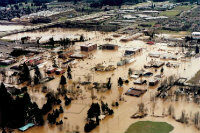The most frequent and damaging natural hazard in the United States

Floods are one of the most frequent and damaging natural hazards we face in the United States. Here in Washington County, there have been many significant flood events in recent times. One of the greatest floods occurred in February of 1996. It was caused by a high precipitation event immediately following a snow and ice storm. The combination of rain and melting snow resulted in flooding along the Tualatin River that broke all-time records. The flood caused millions of dollars in damages to numerous residences, businesses, and public infrastructure along the Tualatin River and its tributaries and resulted in a federally declared disaster. Other notable floods in Washington County occurred in December 2007, January 1974, and December 1933.
Is your home or business at risk?
An important step in preparing for a flood involves determining if your home or business is at risk. One way to assess flood risk is to use the Federal Emergency Management Agency's (FEMA) Flood Map Service Center, which allows you to determine flood risk for a property using an address (try it now). Entering an address will create a map showing any Flood Insurance Rate Maps (FIRM) that have been created for that area. The FIRM shows Special Flood Hazard Areas (SFHA), or areas that have a 1-percent chance of being inundated by flood waters in any given year ("the 100-year flood area"). Determining if your residence or business is in or out of a SFHA gives you the information you need to decide if you should purchase flood insurance. Even if out of the SFHA, flood insurance is a good idea as flooding could occur from a pipe bursting or other reasons. For more information about flood insurance, visit the FEMA National Flood Insurance Program webpage.
Stay away from flood waters

Another very important aspect of flood readiness is knowing how to behave when flooding is occurring. NEVER enter flood waters in a creek, stream, or river. Each year, more deaths occur due to flooding than from any other weather-related hazard. Moving water is extremely powerful and waterways experiencing flooding tend to have swiftly moving water, which could sweep you or your vehicle downstream, posing a significant threat to your life. The Centers for Disease Control and Prevention reports that over half of all flood-related drownings occur when a vehicle is driven into hazardous flood water, and the next highest number of drownings occur when people walk into or near flood waters. These deaths are preventable by just avoiding areas experiencing flooding. Did you know that only six inches of swiftly moving water is enough to knock down an adult, and two feet of water is enough to sweep away most vehicles including large trucks and SUVs? That is why the National Weather Service (NWS) advocates that you Turn Around, Don't Drown–never drive on a roadway covered by flood waters.
Stay aware of ongoing or potential flooding
Floods often provide enough lead time to prepare and get out of harms way. The key to remaining safe during a flood event is to be informed about flood hazards that may happen or are happening in your area. One great source for this information is a NOAA all-hazards radio, which will alert you to any hazardous conditions in your area. And they are inexpensive! Other sources of reliable information include: the NWS Advanced Hydrologic Prediction Service Real-time Simple Syndication (RSS) feeds, which can provide reliable information via many free computer programs or phone apps; emergency notifications in Washington County via text alerts from PublicAlerts; and the FEMA Mobile App, which is a great phone app that provides emergency notifications. Additionally, social media offers some great sources of information - PublicAlerts.org provides information via Twitter (@PublicAlerts) and the National Weather Service office in Portland maintains a Facebook page and distributes information via Twitter (@NWSPortland).
